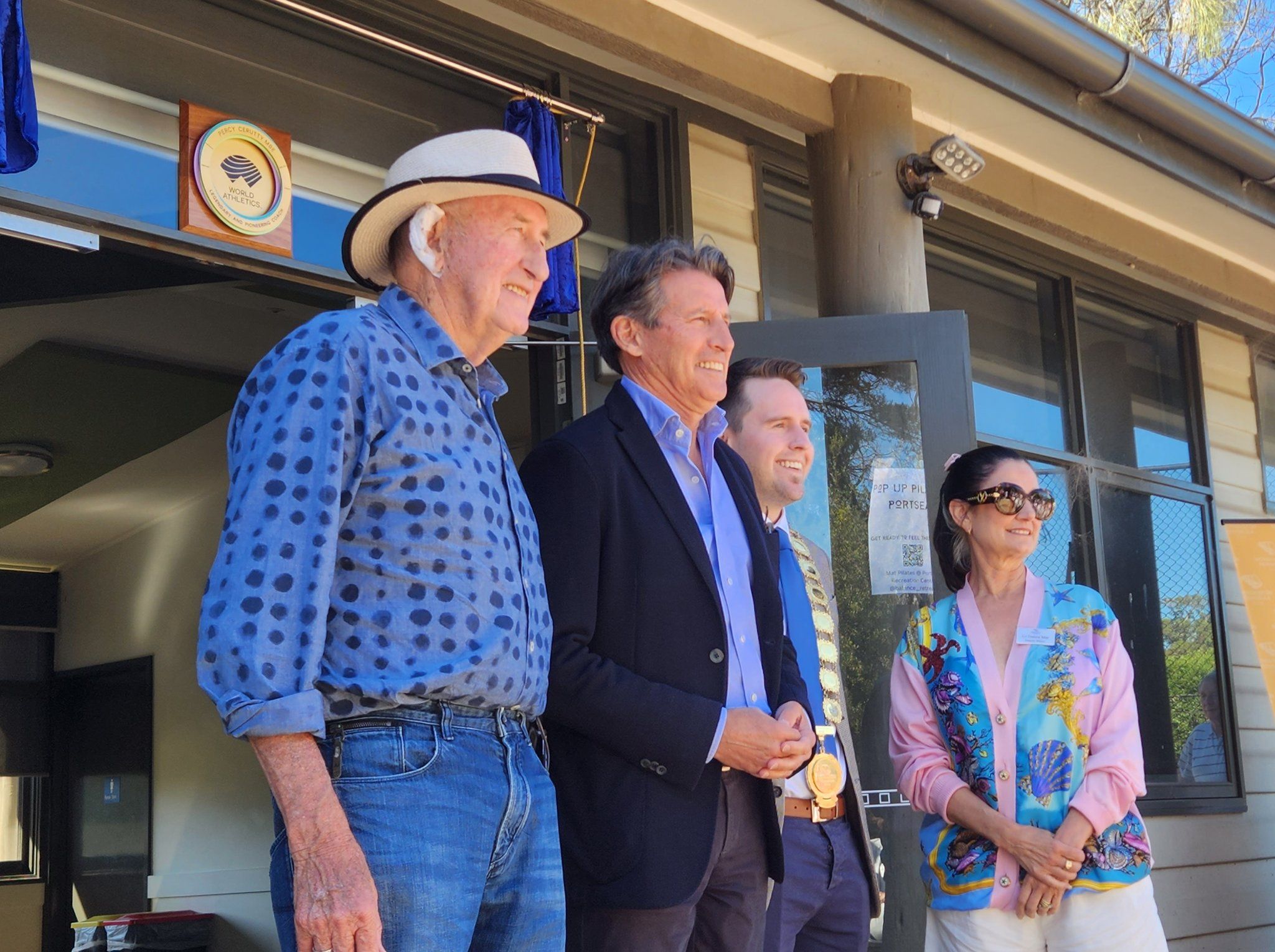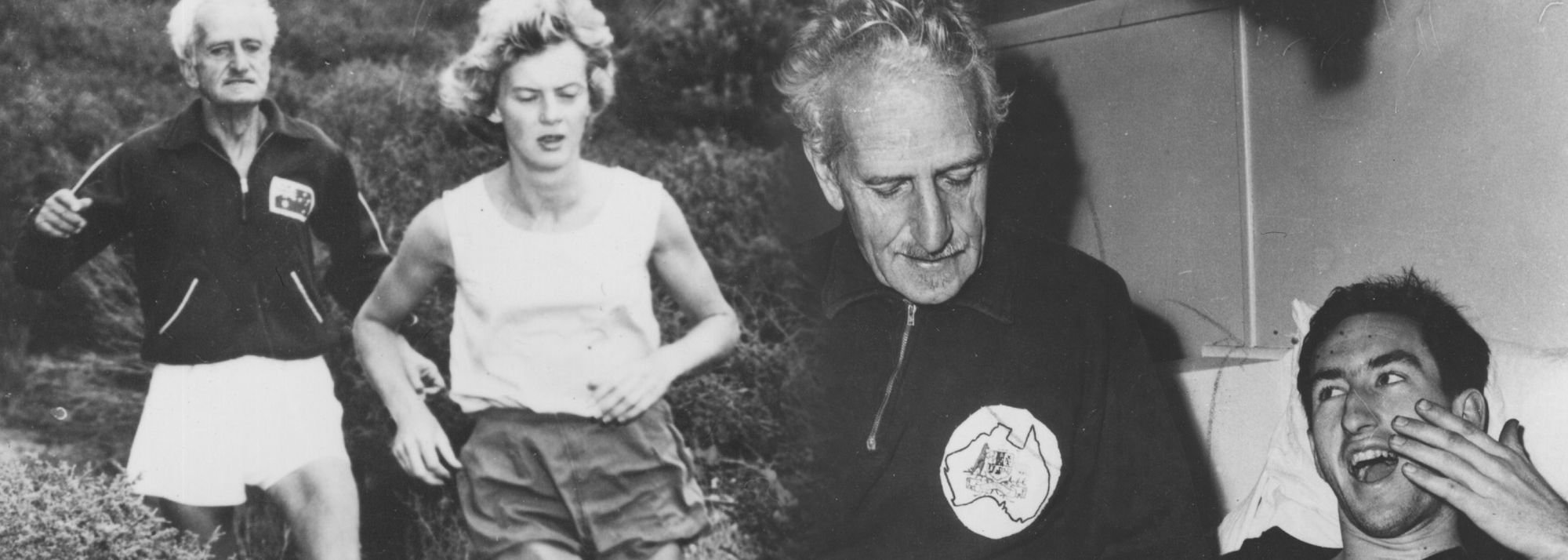Percy Cerutty with Betty Cuthbert and Herb Elliott (© Getty Images)
In Portsea, Victoria, Australia, a World Athletics Heritage Plaque in honour of the coaching career of Percy Cerutty was unveiled by his most famous pupil Herb Elliott, 1960 Olympic champion at 1500m and multiple world record breaker at 1500m and the Mile.
The World Athletics Heritage Plaque is a location-based recognition, awarded for an outstanding contribution to the worldwide history and development of the sport of track and field athletics and of out-of-stadia athletics disciplines such as cross country, mountain, road, trail and ultra-running, and race walking.
Joining Elliott to unveil the plaque, which was awarded to Cerutty on 15 March 2021 in the posthumous category of ‘Legend’, were World Athletics President Sebastian Coe and Councillor Steve Holland, Mayor of Mornington Peninsula Shire, whose local authority organised the ceremony.

Herb Elliott and Seb Coe with Mayor Steve Holland and Deputy Mayor Debra Mar in Portsea (© Jake Stevens)
The plaque is now permanently displayed above the entrance of the pavilion at the Percy Cerutty Oval in Portsea.
In the 1950s, Cerutty and his wife Nancy made their permanent home and set up his famous training camp in the seaside town which is located on Mornington Peninsula. Percy’s grandson Ken Richards, who is the owner of the site of the Portsea training camp, was, along with his wife and children, among the invited guests attending the unveiling.
“It was Herb Elliott who inspired me to become a runner,” said two-time Olympic 1500m champion Coe, “and it was Percy Cerutty’s guidance which honed Herb’s competitive mettle. Percy was an unorthodox, innovative coach whose pioneering approach developed Herb into the outstanding record-breaking, unbeaten miler who first took the world by storm in the late 1950s.”
“I would not be who I am or where I am without the lucky accident of meeting Percy when I was still at school,” reflected Herb Elliott. “He was highly inspiring. To hear Percy talk, you wanted to go out and shake the trees and shake the world. Percy believed ‘nothing worthwhile was ever accomplished without pain, without full effort, without a price’. I adopted his philosophy.”
“It was a pleasure to welcome two super stars of athletics – Herb Elliott and Sebastian Coe – to the Mornington Peninsula to celebrate the life of a local legend,” confirmed Councillor Steve Holland, Mayor of Mornington Peninsula Shire. “Percy Cerutty saw how our unique and beautiful natural environment could be used to benefit the athletes in his care. He will forever be remembered by the Portsea community, not least because the town’s oval is named after him. I’d like to thank World Athletics for this further recognition of one of Australia’s greatest sporting coaches.”
Percy Cerutty – born 10 January 1895 in Prahran, Victoria and died 14 August 1975 in Portsea, Victoria, Australia – was a pioneering and inspirational track and field athletics coach, and the author of six coaching books.
In 1946, Cerutty moved to Portsea and set up a world-famous training camp for runners which especially utilised the local sand dunes for the most rigorous of training regimes.
In Portsea, Cerutty developed his unique and ultimately world famous ‘Stotan’ philosophy – his own special mix of Stoic and Spartan disciplines – based on natural foods, weightlifting, and running in natural surroundings.
Biomechanics were fundamentally important. Cerutty studied the movement of animals with the goal to achieve the most uninhibited, natural form of running. The high speed of most of the training runs he advocated, and the use of short, steep sand dunes of Portsea were central to his conditioning philosophy.
In the distance running world Cerutty was a pioneer in the use of weight training. His emphasis was on low repetitions using maximum weights to build strength but without the risk of bulking up.
Gymnastics exercises such as chin-ups, parallel bars and vaulting were also employed for strength, coordination and breaking the monotony of running.
Cerutty’s system was all about inspiration and flexibility of schedule. “Nothing must be dictated, fixed, or regimented,” he said. “When an athlete goes out to train, his body should dictate his needs and he runs according to its capacities and demands.”
World Athletics Heritage







